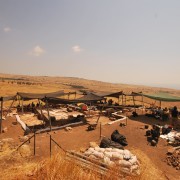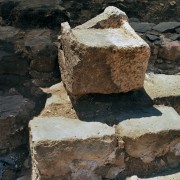Press Release: Significant Archaeological Finds at Horvat Kur (Israel)
During ongoing excavations on Horvat Kur in the Lower Galilee, archaeologists from the University of Bern, University of Helsinki, Leiden University and Wofford College, under the auspices of Kinneret Regional Project, uncovered a unique combination of synagogue features from the Byzantine period. In a cistern close to the synagogue, a wide array of intact Late Roman / Early Byzantine household pottery was found, including many types which had never previously been found complete.
Within the synagogue, a stone seat, with two steps leading up to it, was found in situ atop the bench along the southern wall. This seat was probably used by the leader of the congregation during its gatherings. It is the first such seat ever found in situ in Israel. In addition, in the center of the southern wall excavators found the remains of the podium (“bemah”) on which the torah shrine would have been placed. Several architectural fragments of the shrine were found, including a threshold in classical style, a finely decorated corbel stone, remains of a lion relief, and a rosette. All of these finds demonstrate the high significance of the podium in the synagogue, and the importance of the synagogue as a center of community and religious life.
Certainly the most spectacular object unearthed in the excavations, however, was a basalt stone, shaped like a low table and decorated with figurative elements on one side and geometric patterns on the other three sides. The Horvat Kur stone resembles a similar piece discovered a few years ago at nearby Migdal. The Horvat Kur stone is made of a different material (basalt), and it was found in a secondary, 6th c. AD context, i.e. integrated into a stylobate wall. But the stone certainly belonged to an earlier phase of the synagogue building. Scholars have been divided about the function of the “stone table” from Migdal: was it used as a “reading table” or stand for a lectern? The Horvat Kur stone may help answer these questions, although it may also lead to entirely new lines of research.
Officials from the Israel Antiquities Authority emphasize that these discoveries will more fully illuminate the features of synagogue life in Byzantine period Galilee. They will certainly stimulate the growing field of synagogue research. The finds will officially be presented at the International Colloquium of the German Society for the Exploration of Palestine in Mainz from November 2-4, 2012.




